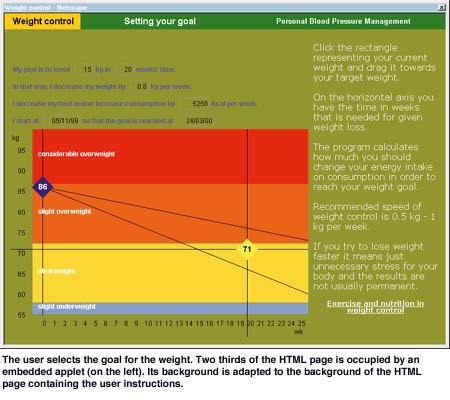OVH Software for Self Supported Blood Pressure Monitoring
by Timo Tuomisto
VTT Information Technology is participating in the development of a software prototype, which provides assistance to manage one’s blood pressure. The OVH system provides background information of reasons and effects of elevated blood pressure, and offers tools for follow-up and planning of associated actions.
Elevated blood pressure is a risk for cardiovascular diseases. The Finnish Heart Association recommends that the levels for systolic and diastolic blood pressure of adults shouldn’t exceed 130 mmHg and 85 mmHg, respectively. According to this criteria, about half of the Finnish population has a reason to follow-up their blood pressure. Of those about 450 000 people suffer from elevated blood pressure.
Many of the risk factors for elevated blood pressure (except for the genetic inheritance) can be controlled by our daily habits. The risk factors include eg decreased activity, high cholesterol, salty, fatty, energetic food, and smoking. Most of these manifest themselves in the weight, i.e. in the energy balance between nutrition and activity. The software concentrates on keeping weight in tolerable limits, although it is also used to map and follow-up the other risk factors as well.
When starting the software for the first time, the user is requested to fill in basic information of himself/herself, and evaluate the current weight and height as well as nutritional and activity habits. Based on these mappings, the software indicates areas of improvement. More over it gives tools to make a weight control plan based the body mass index calculated from height and weight. An estimate of the change in energy balance needed to realise this weight loss is calculated, and the user can begin to play around to achieve this goal either by increasing the current level of activity or by reducing the total amount of energy in nutrition. The reduction of energy in nutrition can happen by reducing the amount of food, of replacing a food item by another food item containing less energy.
On basis of the plans, a weekly calendar is used to record the planned activity, as well as to remind about planned changes in other habits, especially in nutrition. Although the software includes a versatile database of the calories, fibre, cholesterol contents of food items, exact recording of all food intake was considered unrealistic, and the calculations are based on only planned changes.
Technically the OVH software consists of HTML pages and inter-operating applets. The reason to select this type of combination originated in being easily able to create and maintain the contents and look and feel of the background information, and have the ability to include sophisticated personal functionality. The applets are realised as Java Swing components, which further enhance the options for impressive look and feel. Also the chosen platform was intended to facilitate the usage of the software across the network. However, that solution for daily use proved to be unpractical and slow: The current version is run only locally, with a local object-oriented database as a backup. Measured results are optionally sent as a batch process to a remote database, which can then be monitored by a physician. The software is multilingual.

The prototype is currently under real life testing by users selected and supervised by health care professionals in Liminka Health Center, and Oulu University Hospital Dept. of Internal Medicine. These organisations have also provided the medical expertise for the project. The co-ordinator for the project has been Polar Electro Corporation. It has also implemented the contents provided by Finnish Heart Association and an expert group. The Laboratory of Human-computer Interaction and Group Technology in the University of Oulu has committed the requirement specification and preliminary evaluation. VTT Information Technology has designed and implemented the software.
Please contact:
Timo Tuomisto - VTT Information Technology
Tel: + 358 3 316 3368
E-mail: timo.tuomisto@vtt.fi
